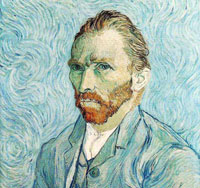Van Gogh's little-known work exhibited first time
The vignette, "A Loving Couple", by Vincent van Gogh has been in private collections for many years. It's exhibited for the first time this fall at the Van Gogh Museum.

Dutch painter Vincent van Gogh owes much of his fame to his image as a troubled genius, but a little-known work on display shows the careful forethought that went into many of his compositions.
It shows a man and woman walking on a path next to a canal, leaning together, her arm over his shoulder.
Painted in March 1888, when Van Gogh was near the height of his artistic powers and two years before his suicide the small piece is all that remains of a larger canvas that Van Gogh discarded as a flop.
"He cut it out carefully and kept it, so there must have been some element, something special that he saw in it," said Nienke Bakker, a researcher from at the Van Gogh Museum who co-organized the display and surrounding exhibition on Van Gogh's friendship with French painter Emile Bernard.
"A Loving Couple" gives insight into how the lost canvas would have looked and how Van Gogh conceived his paintings because he sketched the idea with great accuracy at the top of a letter to Bernard.
"I am sending you a little sketch of a study that is preoccupying me," Van Gogh wrote.
"Sailors coming back with their sweethearts toward the town, which projects the strange silhouette of its drawbridge against a huge yellow sun."
For the exhibition, a reproduction of the sketch, owned by New York's Morgan Museum, is displayed side-by-side with the painting.
With the sketch blown up to scale, the "Loving Couple" would fit perfectly onto it, matching notations of the colors Van Gogh intended to use, down to the word "jaune" French for "yellow" on the man's hat.
The canal water is emerald green, as Van Gogh planned, and the woman is draped in an orange shawl. Although the path is mostly brown, rather than pink, as Van Gogh indicated, he began with pink and then later colored on top of it.
Bakker said it appeared from a letter Van Gogh sent to his brother Theo, a Paris art dealer, that he had begun the work at the bridge, but was forced by bad weather to continue in his studio.
There he apparently lost his initial vision, and Vincent told Theo he had ruined the painting by "overworking" it.
The painter later did several more full canvases portraying the same bridge outside Arles, France, from different perspectives, and one of these that closely matches the lost "Loving Couple" canvas is displayed on the other side of the painting for comparison.
It is more realistic and more tranquil than the jarring juxtapositions Van Gogh imagined in the letter to Bernard.
"A Loving Couple" is on display at the Van Gogh Museum through January.
Van Gogh was born in the Netherlands in 1853. After failing in other careers, he started painting at age 27, and later traveled to France to join the nascent Impressionist movement there.
His letters to Bernard show his longings never realized for lasting friendship and community with other artists.
"The first condition for success is to put aside petty jealousies," he wrote to Bernard. "Only unity makes strength."
A few friends and art connoisseurs recognized Van Gogh's talent during his lifetime, but he was a commercial failure and his life was increasingly troubled by a strange mental illness that led him at one point to cut off part of his left ear.
He died of a self-inflicted gunshot wound in 1890, when he was 37.
Subscribe to Pravda.Ru Telegram channel, Facebook, RSS!




